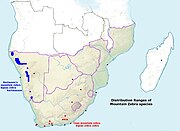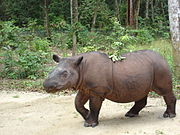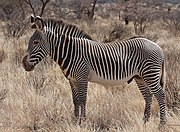bio.wikisort.org - Animal
Perissodactyla is an order of placental mammals composed of odd-toed ungulates—hooved animals which bear weight on one or three of their five toes with the other toes either present, absent, vestigial, or pointing backwards. Members of this order are called perissodactyls, and include rhinoceroses, tapirs, and horses. They are primarily found in Africa, southern and southeastern Asia, and Central America, and are found in a variety of biomes, most typically grassland, savanna, inland wetlands, shrubland, and desert. Perissodactyls range in size from the 1.8 m (6 ft) long Baird's tapir to the 4 m (13 ft) long white rhinoceros. Over 50 million domesticated donkeys and 58 million horses are used in farming worldwide, while four species of perissodactyl have potentially fewer than 200 members remaining. Three subspecies of the black rhinoceros, the Syrian wild ass subspecies of the onager, and the tarpan subspecies of the wild horse have gone extinct in the last 200 years.

The eighteen extant species of Perissodactyla are divided into two suborders: Ceratomorpha, containing the families Rhinocerotidae and Tapiridae, and Hippomorpha, containing the family Equidae. Rhinocerotidae contains five species of rhinoceroses split into four genera, Tapiridae contains four species of tapir in a single genus, and Equidae contains nine species in a single genus, including horses, donkeys, and zebras. Over 75 extinct Perissodactyla species have been discovered, though due to ongoing research and discoveries the exact number and categorization is not fixed.[1]
Conventions
| IUCN Red List categories | |
|---|---|
| Conservation status | |
| EX | Extinct (0 species) |
| EW | Extinct in the wild (0 species) |
| CR | Critically Endangered (4 species) |
| EN | Endangered (5 species) |
| VU | Vulnerable (3 species) |
| NT | Near threatened (3 species) |
| LC | Least concern (1 species) |
| Other categories | |
| DD | Data deficient (0 species) |
| NE | Not evaluated (2 species) |
Conservation status codes listed follow the International Union for Conservation of Nature (IUCN) Red List of Threatened Species. Range maps are provided wherever possible; if a range map is not available, a description of the bovid's range is provided. Ranges are based on the IUCN Red List for that species unless otherwise noted. All extinct species or subspecies listed alongside extant species went extinct after 1500 CE, and are indicated by a dagger symbol "![]() ".
".
Classification
The order Perissodactyla consists of two suborders, Ceratomorpha and Hippomorpha. Ceratomorpha contains the five species in four genera of the Rhinocerotidae family as well as the five species in one genera of the Tapiridae family. Hippomorpha contains a single family, Equidae, in turn containing nine species in a single genus. Many of these species are further subdivided into subspecies. This does not include hybrid species such as the mule, hinny, or zebroid, or extinct prehistoric species. Several perissodactyla subspecies have gone extinct in modern times, namely the southern black rhinoceros, north-eastern black rhinoceros, and western black rhinoceros subspecies of the black rhinoceros, the Syrian wild ass subspecies of the onager, and the tarpan subspecies of the wild horse.
Suborder Ceratomorpha
- Family Rhinocerotidae (rhinoceros)
- Ceratotherium: 1 species
- Dicerorhinus: 1 species
- Diceros: 1 species
- Rhinoceros: 2 species
- Family Tapiridae (tapir)
- Tapirus: 4 species
Suborder Hippomorpha
- Family Equidae (horse, donkey, zebra)
- Equus: 9 species
|
Perissodactyls
The following classification is based on the taxonomy described by Mammal Species of the World (2005), with augmentation by generally accepted proposals made since using molecular phylogenetic analysis.[2]
Suborder Ceratomorpha
Rhinocerotidae
| Common name | Scientific name and subspecies | Range | Size and ecology | IUCN status and estimated population |
|---|---|---|---|---|
| White rhinoceros
|
C. simum Burchell, 1817 Two subspecies
|
Central and southern Africa (Northern subspecies in orange) |
Size: 370–400 cm (146–157 in) long, plus 28 cm (11 in) tail[3] Habitat: Savanna, shrubland, and grassland[4] Diet: Grass[3] |
NT
|
| Common name | Scientific name and subspecies | Range | Size and ecology | IUCN status and estimated population |
|---|---|---|---|---|
| Sumatran rhinoceros | D. sumatrensis Fischer von Waldheim, 1814 Three subspecies
|
Scattered Sumatra and Borneo (former range in orange) |
Size: 236–318 cm (93–125 in) long[5] Habitat: Forest[6] Diet: Twigs, leaves, fruit, and shoots[7] |
CR
|
| Common name | Scientific name and subspecies | Range | Size and ecology | IUCN status and estimated population |
|---|---|---|---|---|
| Black rhinoceros | D. bicornis Linnaeus, 1758 Eight subspecies
|
Southern Africa (extant in green, reintroduced extant in yellow, former range in red) |
Size: 290–310 cm (114–122 in) long, plus 60 cm (24 in) tail[3] Habitat: Savanna, shrubland, and desert[8] Diet: Twigs, woody shrubs, small trees, legumes, and grass[9] |
CR
|
| Common name | Scientific name and subspecies | Range | Size and ecology | IUCN status and estimated population |
|---|---|---|---|---|
| Indian rhinoceros | R. unicornis Linnaeus, 1758 |
Scattered northern Indian subcontinent |
Size: 330–350 cm (130–138 in) long, plus 66 cm (26 in) tail[7] Habitat: Forest, grassland, and inland wetlands[10] Diet: Grass, fruit, leaves, branches, aquatic plants, and cultivated crops[11] |
VU
|
| Javan rhinoceros
|
R. sondaicus Desmarest, 1822 Three subspecies
|
Western tip of Java (former range in orange) |
Size: 300–350 cm (118–138 in) long[7] Habitat: Forest[12] Diet: Bamboo as well as parts of fig trees and guest trees[13] |
CR
|
Tapiridae
| Common name | Scientific name and subspecies | Range | Size and ecology | IUCN status and estimated population |
|---|---|---|---|---|
| Baird's tapir | T. bairdii Gill, 1865 |
Central America |
Size: 180–250 cm (71–98 in) long, plus 5–13 cm (2–5 in) tail[14] Habitat: Forest, shrubland, grassland, and inland wetlands[15] Diet: Leaves as well as fruit, twigs, flowers, sedges, and grass[14] |
EN
|
| Malayan tapir | T. indicus Desmarest, 1819 Two subspecies
|
Scattered southeastern Asia |
Size: 250–300 cm (98–118 in) long, plus up to 10 cm (4 in) tail[16] Habitat: Forest, grassland, and inland wetlands[17] Diet: Leaves, buds, growing twigs, bark, herbs, low growing succulents, shrubs, fruit, club moss, grass, tubers, and aquatic plants[18] |
EN
|
| Mountain tapir | T. pinchaque Roulin, 1829 |
Andes mountains in northwestern South America |
Size: 180–200 cm (71–79 in) long, plus up to 10 cm (4 in) tail[16] Habitat: Forest, shrubland, grassland, and inland wetlands[19] Diet: Shrub leaves[20] |
EN
|
| South American tapir | T. terrestris Linnaeus, 1758 Four subspecies
|
Northern and eastern South America |
Size: 190–240 cm (75–94 in) long, plus up to 10 cm (4 in) tail[16] Habitat: Forest, savanna, shrubland, grassland, and inland wetlands[21] Diet: Fruit, leaves, and other plant material[22] |
VU
|
Suborder Hippomorpha
Equidae
| Common name | Scientific name and subspecies | Range | Size and ecology | IUCN status and estimated population |
|---|---|---|---|---|
| African wild ass | E. africanus Heuglin, Fitzinger, 1866 Two subspecies
|
Scattered northeastern Africa |
Size: 230–250 cm (91–98 in) long, plus 40–45 cm (16–18 in) tail[23] Habitat: Shrubland, grassland, and desert[24] Diet: Grass as well as shrubs[24] |
CR
|
| Donkey | E. asinus Linnaeus, 1758 |
Worldwide | Size: 190–200 in (4,826–5,080 mm) long, plus 40–50 cm (16–20 in) tail[25] Habitat: Desert[26] Diet: Grass, as well as shrubs and desert plants[26] |
NE
|
| Grévy's zebra | E. grevyi Oustalet, 1882 |
Scattered eastern Africa |
Size: 250–300 cm (98–118 in) long, plus 38–60 cm (15–24 in) tail[28] Habitat: Shrubland and grassland[29] Diet: Grass[28] |
EN
|
| Horse | E. caballus Linnaeus, 1758 |
Worldwide | Size: 220–280 cm (87–110 in) long[30] Habitat: Grassland, savanna, inland wetlands, and shrubland Diet: Grains, grass, and shrubs[30] |
NE
|
| Kiang | E. kiang Moorcroft, 1841 Three subspecies
|
Central Asia |
Size: 182–214 in (4,623–5,436 mm) long, plus 32–45 cm (13–18 in) tail[32] Habitat: Shrubland, grassland, and desert[33] Diet: Grass as well as sedges[33] |
LC
|
| Mountain zebra | E. zebra Linnaeus, 1758 Two subspecies
|
Scattered southern Africa |
Size: 210–260 cm (83–102 in) long, plus 40–55 cm (16–22 in) tail[34] Habitat: Savanna, shrubland, and grassland[35] Diet: Grass[35] |
VU
|
| Onager | E. hemionus Pallas, 1775 Five subspecies
|
Central Asia and scattered western Asia |
Size: 200–250 cm (79–98 in) long, plus 30–49 cm (12–19 in) tail[28] Habitat: Savanna, shrubland, grassland, and desert[36] Diet: Grass and succulent plants[28] |
NT
|
| Plains zebra | E. quagga Boddaert, 1785 |
Southern and southeastern Africa |
Size: 220–250 cm (87–98 in) long, plus 47–56 cm (19–22 in) tail[28] Habitat: Savanna, shrubland, and grassland[37] Diet: Grass, as well as leaves and buds[28] |
NT
|
| Wild horse | E. ferus Boddaert, 1785 Two subspecies
|
Central Asia | Size: 220–260 cm (87–102 in) long, plus 80–110 cm (31–43 in) tail[28] Habitat: Grassland and desert[38] Diet: Grass, leaves, and buds[28] |
EN
|
References
- "Fossilworks: Perissodactyla". Paleobiology Database. University of Wisconsin–Madison. Retrieved December 17, 2021.
- Wilson, pp. 629–636
- Burnie, p. 216
- Emslie, R. (2020). "Ceratotherium simum". IUCN Red List of Threatened Species. 2020: e.T4185A45813880. doi:10.2305/IUCN.UK.2020-1.RLTS.T4185A45813880.en.
- Tran, Nghi (2000). "Dicerorhinus sumatrensis". Animal Diversity Web. University of Michigan. Archived from the original on October 5, 2021. Retrieved October 16, 2021.
- Ellis, S.; Talukdar, B. (2020). "Dicerorhinus sumatrensis". IUCN Red List of Threatened Species. 2020: e.T6553A18493355. doi:10.2305/IUCN.UK.2020-2.RLTS.T6553A18493355.en.
- Burnie, p. 215
- Emslie, R. (2020). "Diceros bicornis". IUCN Red List of Threatened Species. 2020: e.T6557A152728945. doi:10.2305/IUCN.UK.2020-1.RLTS.T6557A152728945.en.
- Kurnit, Jennifer (2009). "Diceros bicornis". Animal Diversity Web. University of Michigan. Archived from the original on April 22, 2021. Retrieved October 16, 2021.
- Ellis, S.; Talukdar, B. (2019). "Rhinoceros unicornis". IUCN Red List of Threatened Species. 2019: e.T19496A18494149. doi:10.2305/IUCN.UK.2019-3.RLTS.T19496A18494149.en.
- Fahey, Bridget (1999). "Rhinoceros unicornis". Animal Diversity Web. University of Michigan. Archived from the original on October 5, 2021. Retrieved October 16, 2021.
- Ellis, S.; Talukdar, B. (2020). "Rhinoceros sondaicus". IUCN Red List of Threatened Species. 2020: e.T19495A18493900. doi:10.2305/IUCN.UK.2020-2.RLTS.T19495A18493900.en.
- Crider, Matt (2019). "Rhinoceros sondaicus". Animal Diversity Web. University of Michigan. Archived from the original on October 5, 2021. Retrieved October 16, 2021.
- Wells, Jeffrey (2009). "Tapirus bairdii". Animal Diversity Web. University of Michigan. Archived from the original on August 21, 2021. Retrieved October 16, 2021.
- Garcìa, M.; Jordan, C.; O'Farril, G.; Poot, C.; Meyer, N.; Estrada, N.; Leonardo, R.; Naranjo, E.; Simons, Á.; Herrera, A.; Urgilés, C.; Schank, C.; Boshoff, L.; Ruiz-Galeano, M. (2016). "Tapirus bairdii". IUCN Red List of Threatened Species. 2016: e.T21471A45173340. doi:10.2305/IUCN.UK.2016-1.RLTS.T21471A45173340.en.
- Burnie, p. 217
- Traeholt, C.; Novarino, W.; bin Saaban, S.; Shwe, N. M.; Lynam, A.; Zainuddin, Z.; Simpson, B.; bin Mohd, S. (2016). "Tapirus indicus". IUCN Red List of Threatened Species. 2016: e.T21472A45173636. doi:10.2305/IUCN.UK.2016-1.RLTS.T21472A45173636.en.
- Gearty, William (2012). "Tapirus indicus". Animal Diversity Web. University of Michigan. Archived from the original on October 11, 2021. Retrieved October 16, 2021.
- Lizcano, D. J.; Amanzo, J.; Castellanos, A.; Tapia, A.; Lopez-Malaga, C. M. (2016). "Tapirus pinchaque". IUCN Red List of Threatened Species. 2016: e.T21473A45173922. doi:10.2305/IUCN.UK.2016-1.RLTS.T21473A45173922.en.
- Nechvatal, Natalie (2001). "Tapirus pinchaque". Animal Diversity Web. University of Michigan. Archived from the original on April 16, 2021. Retrieved October 16, 2021.
- Varela, D.; Flesher, K.; Cartes, J. L.; de Bustos, S.; Chalukian, S.; Ayala, G.; Richard-Hansen, C. (2019). "Tapirus terrestris". IUCN Red List of Threatened Species. 2019: e.T21474A45174127. doi:10.2305/IUCN.UK.2019-1.RLTS.T21474A45174127.en.
- Luxenberg, Samantha (2014). "Tapirus terrestris". Animal Diversity Web. University of Michigan. Archived from the original on October 11, 2021. Retrieved October 16, 2021.
- Stuart, ch. Wild Ass and Zebras
- Moehlman, P. D.; Kebede, F.; Yohannes, H. (2015). "Equus africanus". IUCN Red List of Threatened Species. 2015: e.T7949A45170994. doi:10.2305/IUCN.UK.2015-2.RLTS.T7949A45170994.en.
- "Equus asinus Linnaeus, 1758". Charles Darwin Foundation. Archived from the original on October 17, 2021. Retrieved October 16, 2021.
- Huggins, Britton (2002). "Equus asinus". Animal Diversity Web. University of Michigan. Archived from the original on October 15, 2021. Retrieved October 16, 2021.
- Norris, S. L.; Little, H. A.; Ryding, J.; Raw, Z. (2021). "Global donkey and mule populations: Figures and trends". PLOS One. 16 (2): e0247830. Bibcode:2021PLoSO..1647830N. doi:10.1371/journal.pone.0247830. PMC 7906361. PMID 33630957.
- Burnie, p. 213
- Rubenstein, D.; Low Mackey, B.; Davidson, ZD; Kebede, F.; King, S. R. B. (2016). "Equus grevyi". IUCN Red List of Threatened Species. 2016: e.T7950A89624491. doi:10.2305/IUCN.UK.2016-3.RLTS.T7950A89624491.en.
- Clement, Christopher (2015). "Equus caballus". Animal Diversity Web. University of Michigan. Archived from the original on October 8, 2021. Retrieved October 16, 2021.
- "Horses | Livestock Systems". Food and Agriculture Organization Corporate Statistical Database. Food and Agriculture Organization. Archived from the original on April 29, 2021. Retrieved October 16, 2021.
- St-Louis, A.; Côté, S. (2009). "Equus kiang (Perissodactyla: Equidae)". Mammalian Species. 835: 1–11. doi:10.1644/835.1.
- Shah, N.; St. Louis, A.; Qureshi, Q. (2015). "Equus kiang". IUCN Red List of Threatened Species. 2015: e.T7953A45171635. doi:10.2305/IUCN.UK.2015-4.RLTS.T7953A45171635.en.
- Walker, Martha (2005). "Equus zebra". Animal Diversity Web. University of Michigan. Archived from the original on May 27, 2021. Retrieved October 16, 2021.
- Gosling, L. M.; Muntifering, J.; Kolberg, H.; Uiseb, K.; King, S. R. B. (2019) [amended version of 2019 assessment]. "Equus zebra". IUCN Red List of Threatened Species. 2019: e.T7960A160755590. doi:10.2305/IUCN.UK.2019-1.RLTS.T7960A160755590.en.
- Kaczensky, P.; Lkhagvasuren, B.; Pereladova, O.; Hemami, M.; Bouskila, A. (2020) [amended version of 2015 assessment]. "Equus hemionus". IUCN Red List of Threatened Species. 2020: e.T7951A166520460. doi:10.2305/IUCN.UK.2020-1.RLTS.T7951A166520460.en.
- King, S. R. B.; Moehlman, P. D. (2016). "Equus quagga". IUCN Red List of Threatened Species. 2016: e.T41013A45172424. doi:10.2305/IUCN.UK.2016-2.RLTS.T41013A45172424.en.
- King, S. R. B.; Boyd, L.; Zimmermann, W.; Kendall, B. E. (2016) [errata version of 2015 assessment]. "Equus ferus". IUCN Red List of Threatened Species. 2015: e.T41763A97204950. doi:10.2305/IUCN.UK.2015-2.RLTS.T41763A45172856.en.
Sources
- Burnie, David (2017). Animal: The Definitive Visual Guide. DK. ISBN 978-1-4654-7086-7.
- Stuart, Chris (2017). Stuarts' Field Guide to the Larger Mammals of Africa. Penguin Random House South Africa. ISBN 978-1-920572-28-0.
- Wilson, Don E., ed. (2005). Mammal Species of the World. Vol. 1 (3rd ed.). Johns Hopkins University Press. ISBN 978-0-8018-8221-0.
Другой контент может иметь иную лицензию. Перед использованием материалов сайта WikiSort.org внимательно изучите правила лицензирования конкретных элементов наполнения сайта.
WikiSort.org - проект по пересортировке и дополнению контента Википедии

















